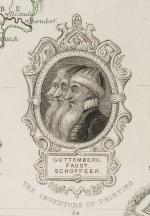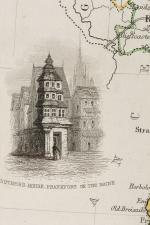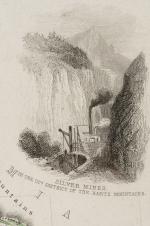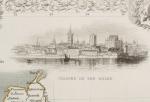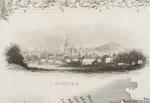Tallis, Germany - with Vignettes of Coburg, Cologne on the Rhine, Dresden, Silve
Germany – with Vignettes of Coburg, Cologne on the Rhine, Dresden, Silver Mines in the Upper District of the Hartz Mountains, Martin Luther’s House in Frankfort on the Maine [Haus in Frankfurt am Main in welchem Martin Luther wohnte], the Palace at Saxe-Gotha and Portraits of the Inventors of Printing: Johannes Gutenberg, Johann Fust and Peter Schöffer.
Original steel engraving / Vintage map. Drawn and engraved by John Rapkin. Partly hand-coloured. Illustrations by N. Whitlock and Engraved by J. Rogers. London, Edinburgh & Dublin, J & F. Tallis, 1851. Plate Size: 25 cm x 34.8 cm. Sheet Size: 27.5 cm x 37.4 cm. Vintage 19th century map in very good condition.
Published in the Illustrated Atlas, And Modern History Of The World Geographical, Political, Commercial & Statistical, Edited By R. Montgomery Martin.
Beautiful and fascinating map of a fragmented Germany from the Victorian Era. The coloured delineation show the patchwork of kingdoms, duchies, states and ‘Kleinstaaterei’, or mini-/micro-states that comprised much of the territory of the ancient, and recently expired, Holy Roman Empire. The Kingdom of Bavaria is the largest of these, with Saxony and Hanover also significant local powers. The non-contiguous Coburg, a tiny state, exerts outsized influence due to its ties with the British Royal family: reigned Queen Victoria was the daughter of a Coburg princess. Miniature Oldenburg, Hesse, Biankenburg and Gottingen vie with each other in this crowded field of states. Prussia also has outposts in this busy area, around which are Holland, Prussia, France, Switzerland, Tyrol, Bohemia, and the already-mentioned Prussia. The railway system is shown, as are the numerous towns and cities of the region. Relief is depicted with hachuring.
A doubled-head eagle accompanies the titular cartouche and a decorative border is adorned with armorial coat-of-arms and ceremonial medals – suggestive of the necessary pomp-and ceremony of such a thronged political and diplomatic landscape.
John Tallis (7 November 1817 – 3 June 1876) was an English cartographic publisher. His company, John Tallis and Company, published views, maps and atlases in London from roughly 1838 to 1851.
Tallis set up as a publisher with Frederick Tallis in Cripplegate in 1842; the business moved to Smithfield in 1846, and was dissolved in 1849. From 1851 to 1854 Tallis operated as John Tallis and Company. He started The illustrated news of the world and national portrait gallery of eminent personages in 1858, selling it for £1,370 in 1861; it folded in 1863. (Wikipedia)
The most important project John Tallis undertook, was the ‘Illustrated Atlas’ from 1851. The original map we offer here, was part of this exceptional Atlas and all the maps it contained are still today considered as the last reminder of an era of lavish map production. Tallis worked the project together with John Rapkin (1815-1876) and it was Rapkin’s style and talent that we have to thank for when we marvel at these maps today. What makes these maps so special is the detail of engraved vignettes that surround the map and often show indigenous scenes, people in their environment and even more so, historical buildings or historical views of towns and cities, architecture and landscape.
The project of ‘The Illustrated Atlas’ was designed to be finished just in time for the anxiously awaited “Great Exhibition of the Works of Industry of All Nations” or The Great Exhibition, sometimes referred to as the Crystal Palace Exhibition in reference to the temporary structure in which it was held, was an international exhibition that took place in Hyde Park, London, from 1 May to 11 October 1851. It was the first in a series of World’s Fairs, exhibitions of culture and industry that became popular in the 19th century, and it was a much-anticipated event.
The Great Exhibition was organized by Henry Cole and Prince Albert, husband of the reigning monarch, Queen Victoria. It was attended by numerous notable figures of the time, including Charles Darwin, Samuel Colt, members of the Orléanist Royal Family and the writers Charlotte Brontë, Charles Dickens, Lewis Carroll, George Eliot and Alfred Tennyson. Music for the opening was under the direction of Sir George Thomas Smart and the continuous music from the exhibited organs for the Queen’s procession was “under the superintendence of William Sterndale Bennett”. (Wikipedia)
- Keywords: 19.Jahrhundert · 19th Century · 19th Century Map · Alte Landkarte – Deutschland · Cartography · Catalogue No.5 – Maps of the World · Deutschland · Europe · Germany · John Tallis Maps · Landkarten · Map · Original Map · Original Maps · Original Steel Engraving · Prussia · Rare Map – Germany · Travel Germany – Rare · Vintage Map · Vintage Old Map
- Language: English
- Inventory Number: 200104AG
EUR 350,--
© 2025 Inanna Rare Books Ltd. | Powered by HESCOM-Software





